Dearest HERD friends! We have been very busy behind the scenes and have been compiling the most accurate version of the events that played out last month concerning a drop in Phabeni’s health. Following on from part one which we shared in a blog, we now can inform you about the plasma transfusion that followed.
By Adine Roode
It was forecast to be a hot day and so we decided to start at 6am with the transfusion procedures. I chose Mambo to be the blood donor for little Phabeni. First, we had to sedate Mambo before putting in the IV line. Usually when you donate blood, you don’t feel anything except the little prick, however they supply you with juice and perhaps a sweet cookie in South Africa, should you not feel well. With the elephants, there is of course no way that they will allow Dr Rogers to prick them with a needle. A standing sedation works well with the elephants. Our elephants have in fact played an integral part in the research of BAM, the abbreviation for a combination of butorphanol, azaperone and medetomidine administered in a standing sedation.

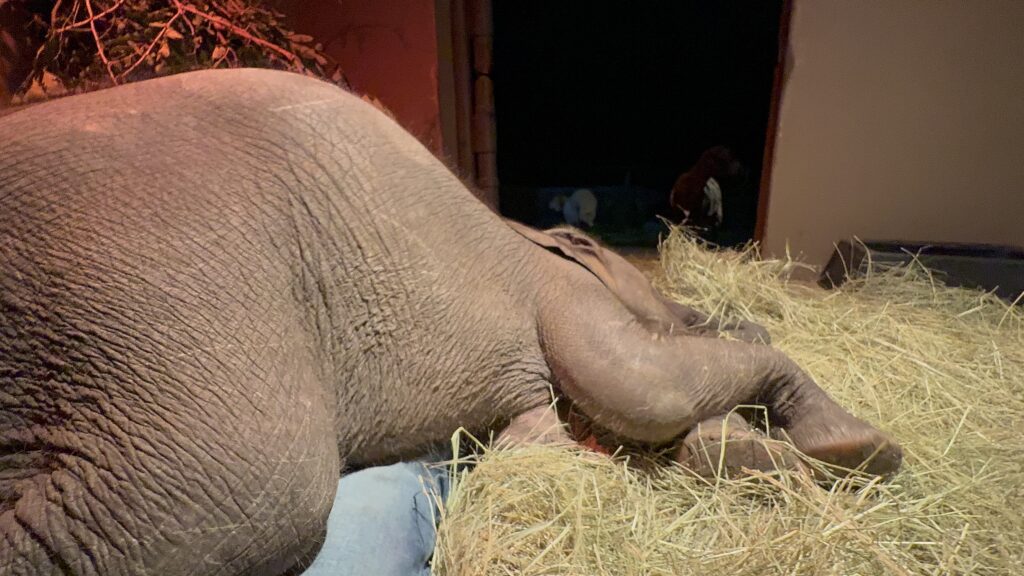
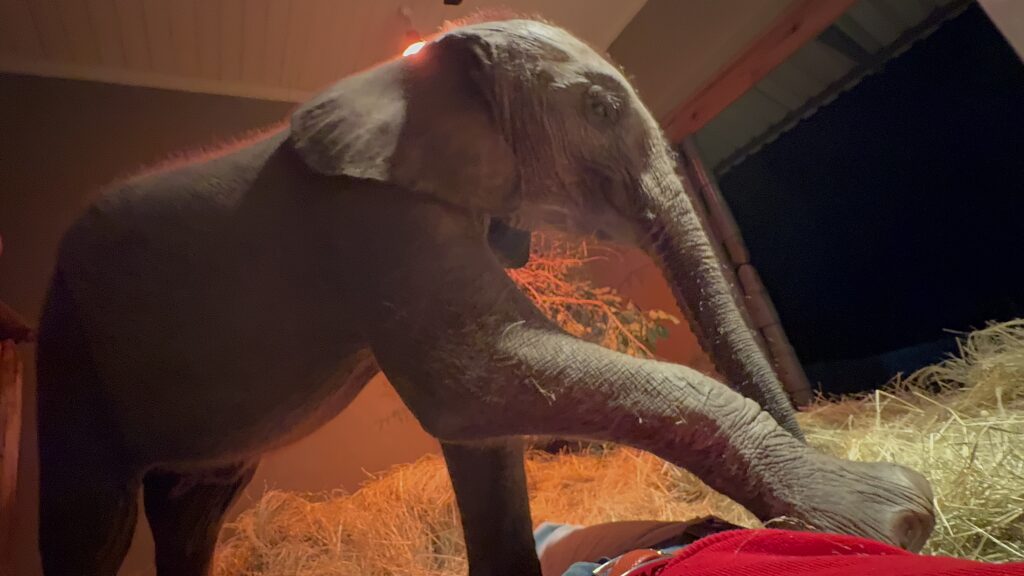
It was a cool morning still and we were concerned that we would not easily find a vein to draw blood from, but luckily Mambo’s veins in his legs were good and we could fill two pints of blood. When choosing a donor, you look at a healthy animal as you want to restrict transmission of diseases.
Previously with other calves, we used Setombe as the blood donor, but because she has an important role to play in caring for Phabeni now, she wasn’t an option this time. Mambo was a star donor. While Mambo was sedated, the herd was close by and the carers fed them lucern to keep them occupied. After Dr Rogers reversed the BAM, Mambo joined the herd again, and we moved over to Phabeni at the orphanage.
Blood transfusions have been practiced over centuries for both humans and animals and have saved many lives. In 1665, Richard Lower did the first blood transfusion in history on a dog. Blood transfusion became more popular in animals after the techniques and equipment used improved during the 1950’s. As in humans, animals do have different blood types, however we are not aware of blood types in African elephants – perhaps this is a research study that we can put on our to do list.
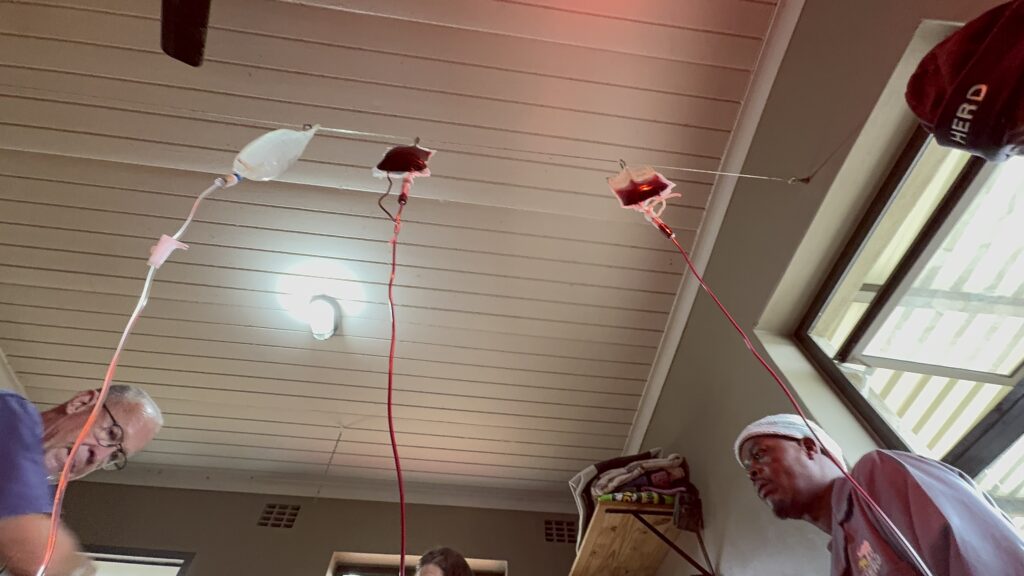
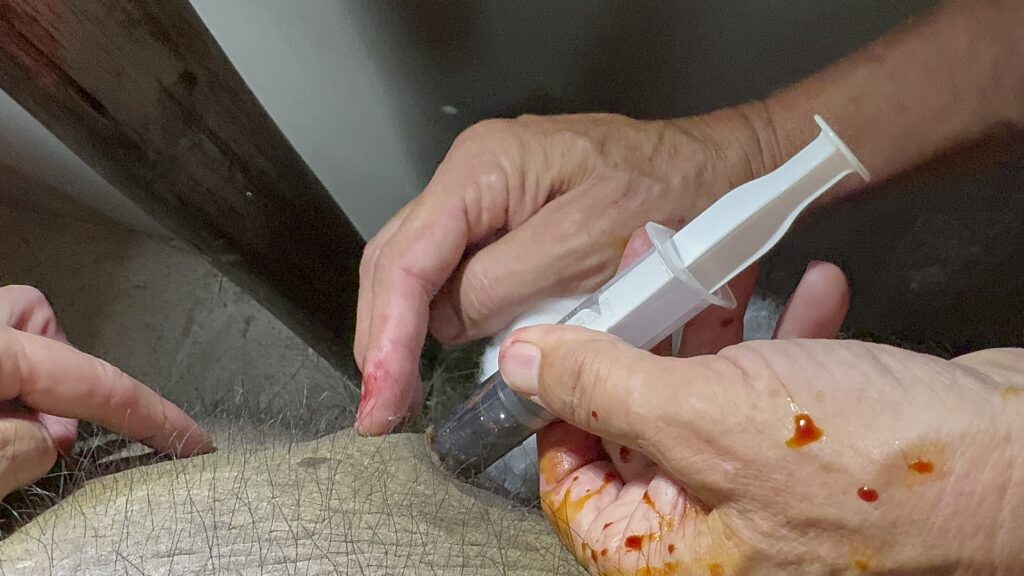
The week prior to the transfusion was tough with Phabeni not drinking all his milk bottles, as well as undergoing two previous sedations so that we could clean the wound you will have seen on his rear. We had also administered drips to prevent dehydration. Interestingly enough, Phabeni’s energy levels were always good, but I think the fact that he was out with the Jabulani herd every day meant that he ate a lot of grass, leaves, bark and some roots that the bigger elephants would drop and share with him. Therefore he was getting in a good ‘batch’ supplementation to his milk. Although the second set of blood results showed an improvement on his amylase counts, we noticed that the wound on his rear was swollen again.
The main indication for Phabeni’s blood transfusion was the treatment of anemia and chronic inflammation because of his wound, but also because in all of our orphan calves at the age of 11 months there is a dip where they struggle with their health, and stop taking bottles. Thus, a secondary reason for doing a blood transfusion was to maintain Phabeni’s health and prevent a serious dip, where you suddenly need to fight for a life. We are fortunate that this is an easy option for us since we have access to elephant blood donors who are strong and healthy.
Unfortunately wildlife vet, Dr Johan Marais was unable to attend to the X-rays at that time and we were still uncertain on what the exact reason is for the wound on Phabeni’s rear not healing properly (a wound caused we think by the tranquiliser dart during his rescue in November 2023).
Once again Phabeni was darted with BAM. It took approximately 20 minutes for him to be totally ‘out’. As he had two drips in the previous seven days, it was tricky to get a vein in his ear, but luckily with Dr Rogers’ experience, he was able to find a vein for the IV. As blood is thicker than saline, it took more time for a transfusion, compared to a drip. Excessive and rapid injection of blood and plasma can result in circulatory overload and heart failure. Blood should be given intravenously at a rate of 10mL/kg per hour – starting the transfusion slowly and gradually increasing the flow rate. Warm blood as in this case, should also be transfused over four hours. The volume of blood is determined by the recipient’s body weight and reason for transfusion. During 2017, we administrated four pints of blood for Timisa during a transfusion. Khanyisa also received blood in 2020. The amounts are assessed by Dr Rogers after we discuss the clinical observations and previous blood results.
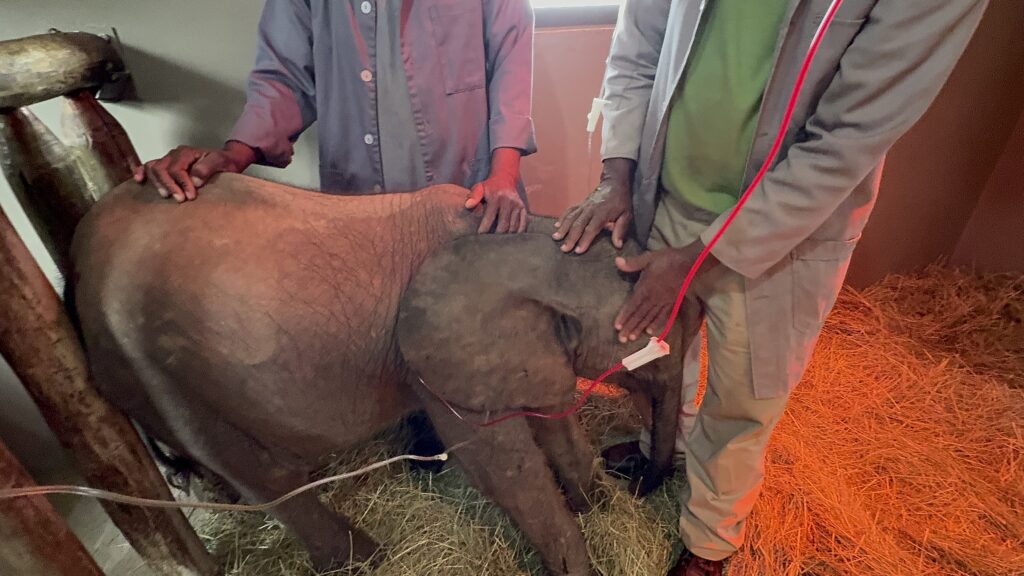
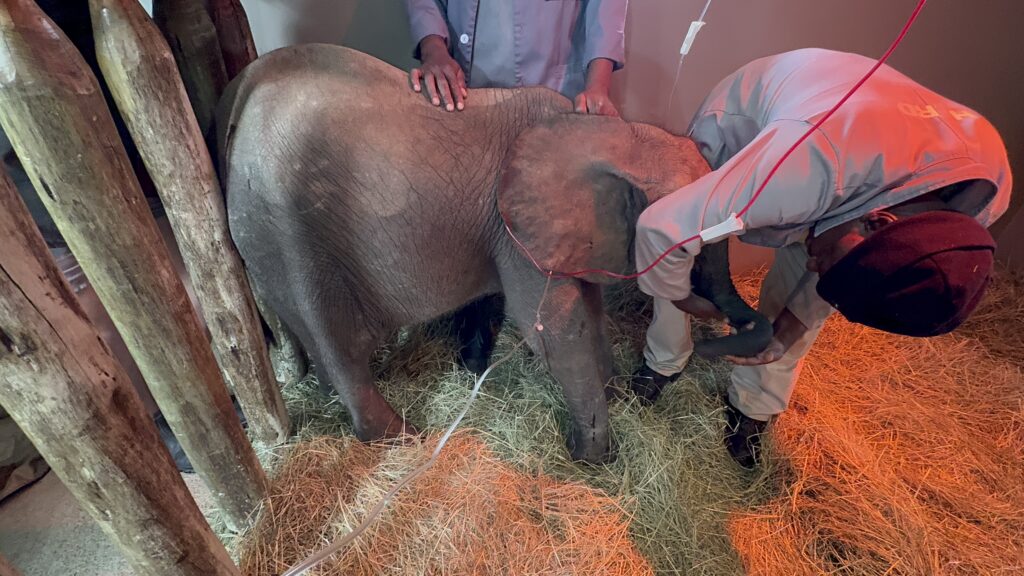
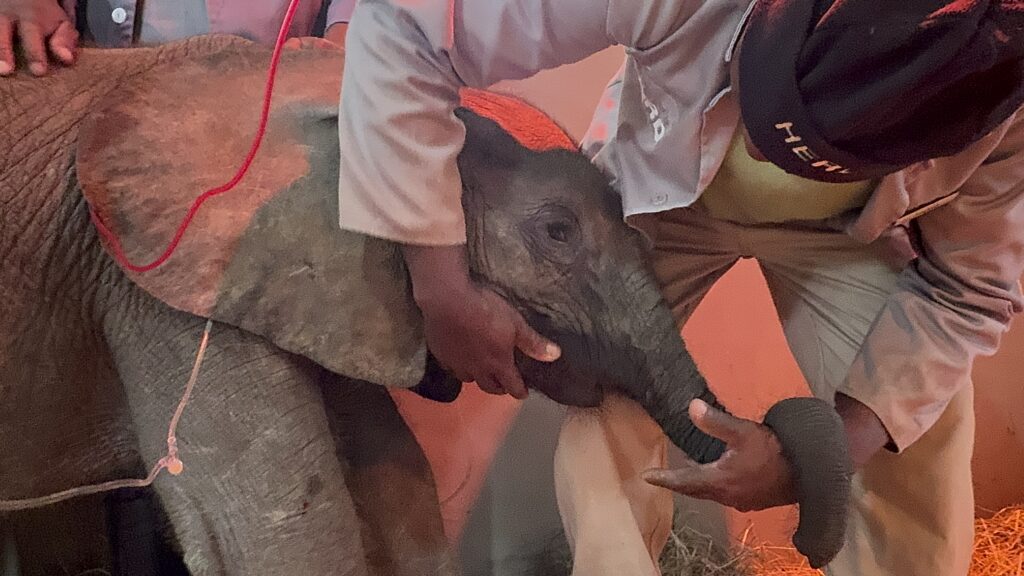
We gave Phabeni two pints of blood as well as drips to make sure that he was well hydrated. Sedation is always risky and vitals need to be checked and monitored the whole time. During sedation, the elephants maintain their natural physiology reflexes and are capable of breathing on their own. But one of the reasons why I choose to be present during any sedation is that we have lost a calf under sedation before, and we nearly lost Khanyisa once under sedation. If I had not picked up on her breathing issue and were Dr Rogers and his assistant Janelle not extremely fast in handling the situation and reversing the sedation, we could have lost her – a thought I can’t bear to think of. The fact is, when a calf is sedated because he is sick, he is already weak and therefore more prone to stop breathing under sedation.
Luckily all went well and after the sedation was reversed, we gave Phabeni some time to be himself again, while Reply prepared his bottle. He drank the milk eagerly before stepping out of the nursery into the orphanage. Setombe and Lundi joined the carers to fetch Phabeni and the little bull left the orphanage just before 11 am to join the herd for the rest of the day in the bush. Keeping him in the orphanage would increase his stress levels as he doesn’t understand why he can’t go out. We didn’t go too far from the homestead though, and fed close by, while we continued monitoring Mambo and Phabeni closely.


We were so relieved and satisfied that all went well and that our little fighting fit bull took all his milk bottles.
A week later, Dr Johan Marais was back at his office and he could check the X-rays that he took of Phabeni. The feedback from Dr Marias on the radiography was as follows: “I manipulated the X-rays to be able to see clearly as theoretically there should be dead tissue. When you have a wound on a human or animal that keeps on popping up open – so it heals and pops open, then it heals and pops open – that means there is a foreign body or object inside which the body is trying to get rid of. That foreign body can be anything from a needle, a piece of material, a dead piece of bone, a dead piece of tissue or a piece of wood and all of that classifies all as a foreign object that the body wants to get rid of. I can see clearly in two of my X-rays that there is definitely a fracture of the tuber coxae that you also get in horses and remember I also told you that it always pulls down – ventral – and this is exactly what happened here.”
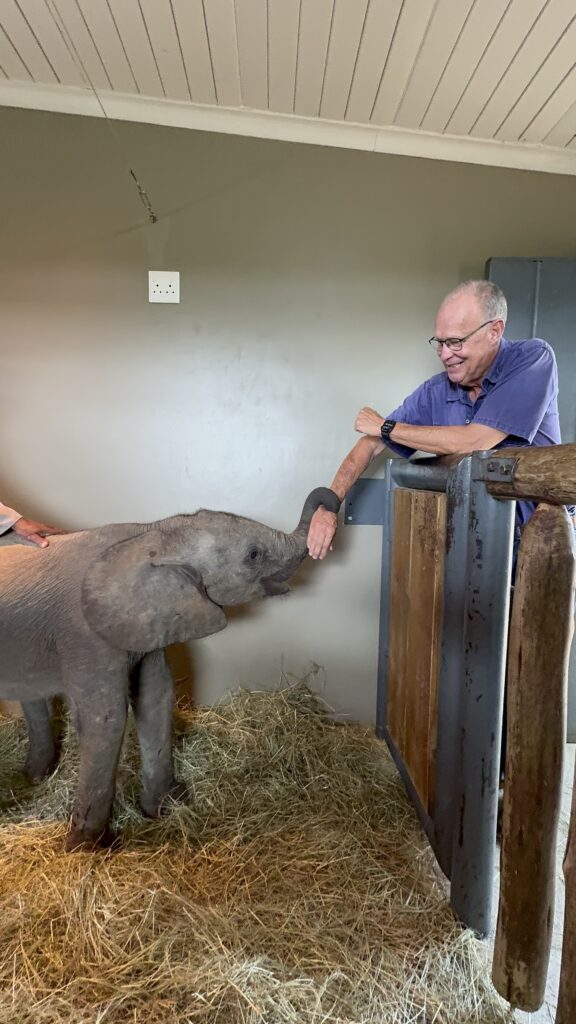
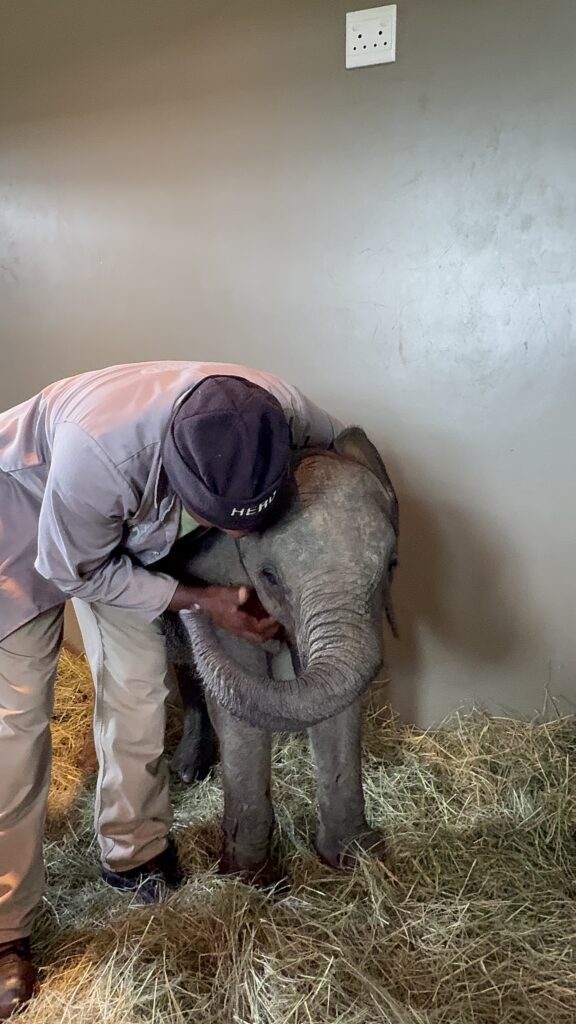
In Phabeni’s case, what seems to be the case in the X-rays was that there was a fracture, a little piece of bone broke off and was pulled ventrally down towards the ground and is sitting about 7 cm ventrally of the wound. It is about 1,5 or 2cm deep, so it is not that deep, which is good. One should remove this foreign object or piece of bone if the wound keeps repeatedly healing and opening, otherwise this wound will never heal, but that should not make the animal sick per say. It is only a local wound and they would not get an infection from the foreign object, just a local wound. Of course you can get a secondary infection if the wound is infected by bacteria from the outside.
It can be quite difficult to find this piece and is not easy always to cut into the elephant to find it, so we always use X-rays or ultrasounds just before we do the operation to increase the success of the operation and finding the foreign piece of material or bone to remove it. Alternatively you can leave it if the wound heals, as the tuber coxae has good muscle attachment which is the reason the piece of bone there is pulled down and has good blood supply and won’t necessarily die. If it dies, you will need to go and get rid of that piece, but you never get it in horses. If it didn’t have the muscle attachment, it would have still been sitting higher and Dr Marais is comfortable that the muscles pulled the piece down and still has blood supply. It is typical of what happens in horses and they will be very sore for a time, but will be fine in the long run. Dr Marais told me that it is called a dropped hip.
At this stage, we are still closely monitoring Phabeni’s wound. The other day it seemed that the wound was swollen, but it seemed that after he drinks his milk, it looks swollen as his tummy is bulging more. It is not warm though and hasn’t opened again. Touch wood, Dr Marais is right and it has healed on its own meaning that a procedure to remove the piece of bone is not necessary. Should it open again, we would need to get Dr Johan Marais in to assist again with his X-ray machine and sonar, so that we can know exactly where the piece is stationed and then Dr Rogers can be exact when removing the piece.
For now, all is good except for every now and then when Phabeni does not taking the occasional bottle of milk. We are adapting the milk as he is heading to one year of age, more or less. The process of adapting milk volumes and ingredients is a typical part of looking after elephant orphans. There is not a single recipe for all elephant orphans and we need to keep tweaking things to fit the best recipe plan for that specific calf. Once they get older, it gets easier, but for now it takes time, knowledge, patience and staying openminded so that we do not miss any of the signs that our little Phabeni shows us.
Thank you for your concern and support for Phabeni and for caring about his continued well-being. We will always keep you updated as the months tick on. You will know, if you watched our journey with Khanyisa, that raising elephant orphan calves is tricky work filled with ups and downs, and as such our team is ready and equipped to deal with each challenge.



 Comment
Comment
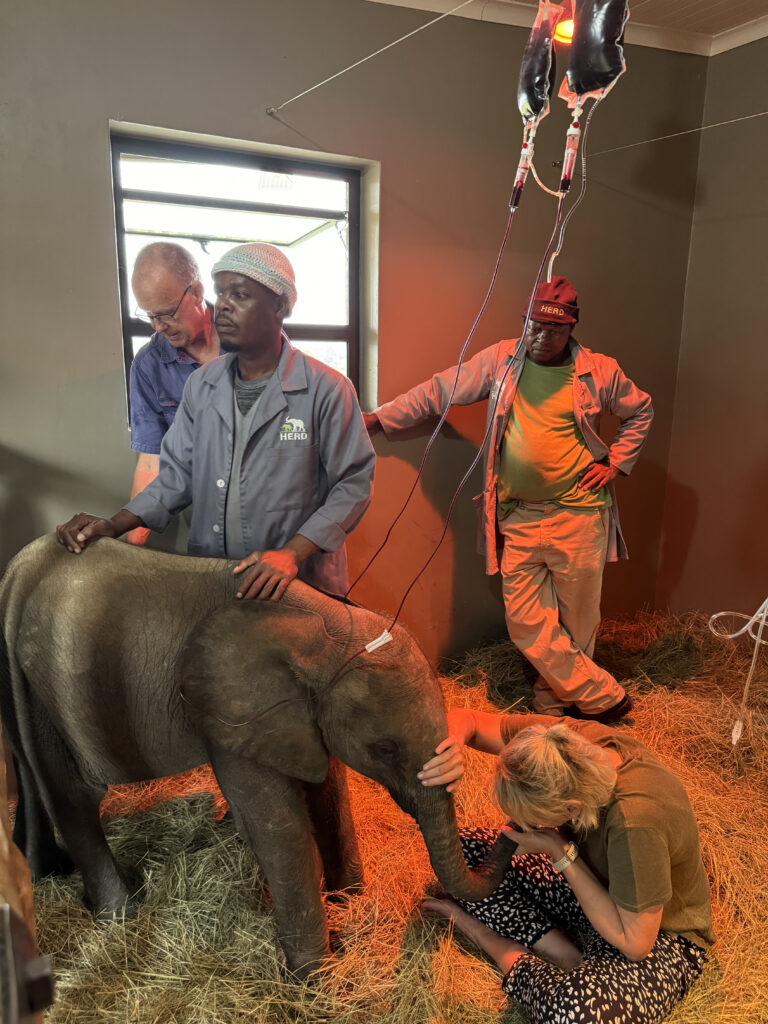
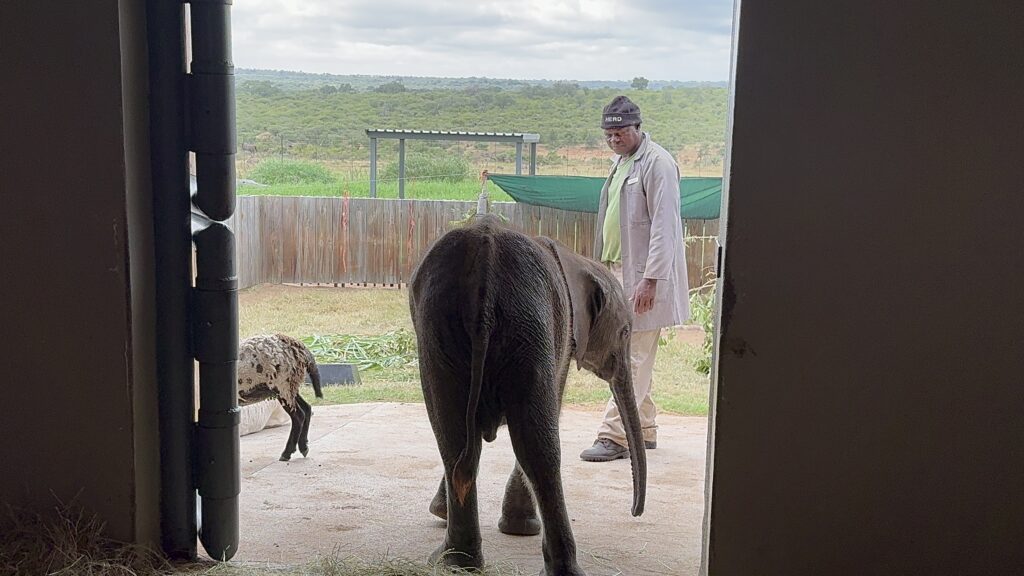

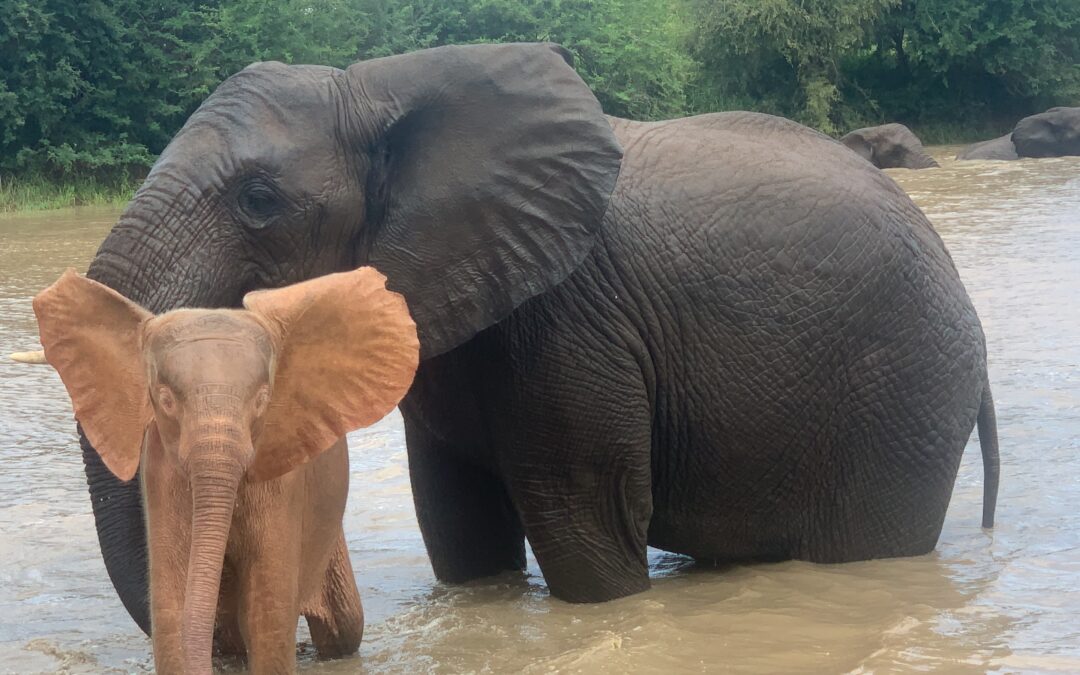

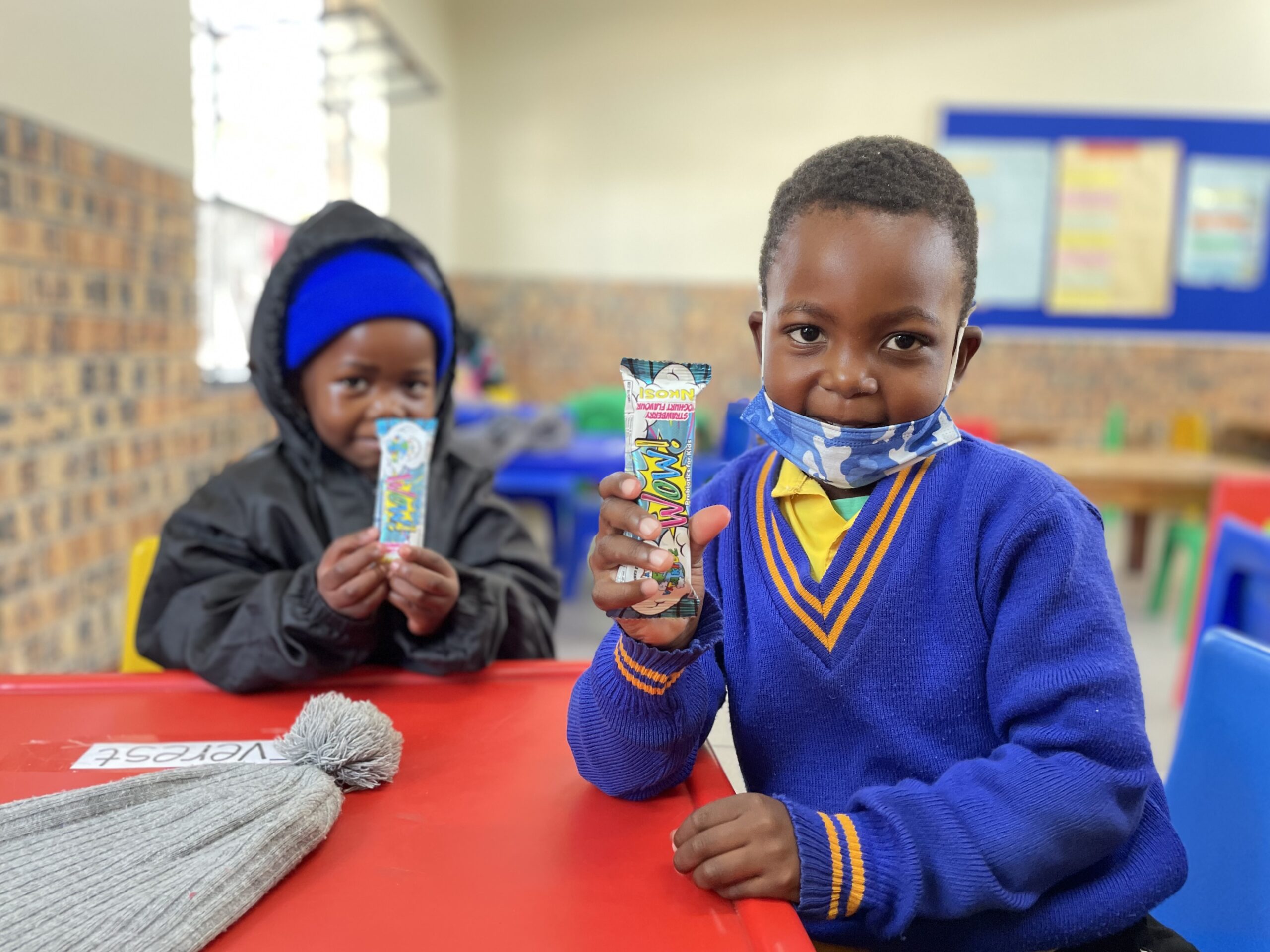



Wow, how stressful for you all Adine. Phabeni is a baby, but I hope his Mom tells him that his human herd only ever wants him to be well. much love. 🐘
This all sounds like great news! It’s your knowledge of past Ellie’s, both here & in the Skies, that make this possible. I enjoyed the pictures very much‼️ We can’t thank you enough for keeping us in the loop. Blessings to all,
Stacie
TX, USA
goodness me had no idea that there was a reason for him to be playing with his bottles, in fact never gave it a thought how complexed this little bull and his health issues are thank you once again for all your love and deadication
I have been so worried about little Phabeni. Thank you so much for the update.
I’m so relieved that our baby boy is doing better. He’s getting the best medical care possible and all the love needed from Adine and his Carers to come through all this and live a long and happy elephant life. Many thanks to Adine, all Phabeni’s Carers. Dr. Rogers and Dr. Marais. you are all the BEST and little Phabeni is so lucky to have all of you on his team! Keep fighting little one. You are so loved by both humans and all your elephant Herd.
Sending much love to all of you and I hope and pray little Phabeni will soon be feeling like his feisty self again.
I am praying Phabeni will be well ❤️🩹❤️🩹❤️🩹❤️🩹 soon,and back to him poseing for the camera,and running with his blankie, Lots of Love 💕💕💕💕💕😘😘😘 Phabeni Sue Cash: USA.
Thank you for your this extensive update. So glad things worked out well for Phabeni and Mambo too. Now hopefully that wound will heal as well, at least you know now what is causing the problem. Sending you and Phabeni all my love❤️
Thank you !! Adine and to the 2 talented Vet’s they took the good d’ecisions with many interrogations !! but little Phabeni has been very close the the death !! when I watch the Stavros and keepers faces they break my heart 🥲 I do hope Phabeni won’t get an other infection !🙏🏼 Khanyisa and Phabeni are 2 exceptional babies , so different but unique I have been very anxious for Phabeni He was under a big mental trauma !! till he meets with the herd !! Setombe and Phabeni are really mum and son !! it’s amazing and so heartwarming !! Thank you Adine for the update 2/ about What happened to Baby love !! thank you all of you !! thank you Mambo !!! Phabeni amazes me because he is a boy with strength !! and his character but he needs so much love as a baby when we watch him with Setombe he is full of love cuddles and big hugs with her ! it’s wonderful for all the Herd too !!
Warmly
Claudine
Sending Lots of Love, Light, Protection, Healing, Prayers and Blessings to Phabeni & the Jabulani HERD 🧚🏽♀️🙌🏽💖🕯️💫
Phabeni 🐘 is right where he needs to be. Thank you Dr. Rogers and Dr. Marais for looking after Phabeni 🐘. I to have watched his wound in earlier videos and wondered why it was not healing. Now I understand why. To Adine and all of Phabeni’s 🐘 carers. Thank you for loving and caring for this feisty little bull. Just a question. Do wild babies who are teething have these issues also? Thank you Mambo 🐘 for giving the gift of life to Phabeni 🐘. Thank you for keeping your followers updated on Phabeni’s health. Love ❤️ always from Florida.
❤️❤️🐘🐘❤️❤️.
Are you an angel, Adine? You’re certainly too good to be human.
Because of the high degree of intelligence that I have observed in these elephants, I would not discount psychological trauma. It has been said, elephants have amazing memories. I believe, and have sensed from little Phabeni that he does remember his previous herd and Mother. I don’t know what happened to have him end up in that family’s backyard. It was something. Perhaps one day we will know. You guys are the best! I always enjoy learning more about these fabulous animals!
Thank God everything went well! I can only imagine how stressful the sedation must be for you all, but the skill of the vets and carers alike saved the little bull. On to the next phase of his care now.💖
You are wonderful people. God bless you. I love you all.
I am so glad Phabeni is getting better, he is such a spunky, loveable little bull. I love watching his antics every day. Thank you team for all the caring you give to the whole of the Jabulani tribe
May the Lord continously bless you Aidine and all carers at HERD for being the Lord’s heavenly hands to keep all baby ellies and bigger ellies in good health and saving their lives
I love you all
Thanks be to gracious God and all who have been appointed to care for Baby Phabeni. 🙏☝️🙏💙✌️💙
I love reading these blogs. One never knows what is going on behind the scenes and this is good information. Thank you all for your dedication and hard work!
Hey team HERD, you guys are doing a wonderful job. Keep up the spirit. I will definitely donate but as of now have not received my salary from past 6 months. I have adopted a baby elephant calf named Bani in India and I want her also to recover soon as she’s currently undergoing neurological treatment, induced by trauma.. I would pray for Phabeni as well as I have been closely watching over him since past one month. May he get well soon and run over your fields out of naughtiness.. Please keep on doing the noble work. I would love to do something for elephants at large because I can’t see them in captivity. I would be glad if you can show me a direction and make me a part of your journey..
Your hard work and vigilance is impressive and will hopefully pay off for our dear sweet imp Phabeni and the Moms and Pops!
God bless 🐘 Phabeni and all of you at HERD as well as Dr.Rogers & Dr.Marais for their dedication in Phabeni’s care & well being. To Adine & your Staff, I know how hard this event was for all of you cuz you could see it in your faces so I want to send a special prayer as well as all my 🫶💜💕 & sincere thanks to all of you for the work, dedication, 🫶🐘 that you all pour out to these🐘’s each & every day! You all are 🐘😇&🐘🎖️’s!!!
thank you for such great care. only those familiar with Phanabi would realize any distress. How wonderful you all have such a watchful eye and know solutions to these problems. He is such a great boy!! thank you again for all your love to him.
thank you so much for all you do and the further update on Phabeni.
> “You will know, if you watched our journey with Khanyisa, that raising elephant orphan calves is tricky work filled with ups and downs, ”
All too well. I don’t know how you all cope with it. And of course we remember you’ve been through the mill before horribly. So relieved to hear that Phab is fab again and very grateful for the honest – and educational – write up. Small elephants are shockingly fragile. So: solidarity and love from over here and sympathy and thanks for all your sleepless nights. He is more than worth it. With you every minute through think and thin, Calvero
Bless you ALL!!🙏🙏 💖💕 Praying for your full recovery, Baby Phabeni 🙏🙏💖💕 I love you very much
My heart sank, when I saw the video today. I didn’t realize, that this had happened in March.Grateful, that little Phabene is fine now and enjoys being with his elephant family.
There are no words to express my admiration for all of you, who tirelessly are making sure that all the elephants are in good health and safe. It surely is a labour of love. May God keep blessing each one of you with excellent health,strength and courage, to keep doing what you are doing to help these wonderful creatures.
Sending lots of love and prayers for Phabeni, the Elephants and the beautiful team at HERD for taking such great care of these amazing gentle beings., 🙋🏼♀️
🙏❤️🐘🐘🐘…
so glad he is ok for now. Hope everything will go smoothly.
Ek is Bly Phabeni is beter .Ek is mamma wat my seun en man begrawe het en Phabeni gee my iets om na uittesten in my gebrokenheid
Thank you for keeping us posted about Phabeni. He is getting such wonderful care from you Adine, all of the carers, the doctors, and not to forget the herd he lives in! Prayers for the entire HERD organization as you work tirelessly to care for each of the ellies!
for
Thank you for the wonderful and insightful explanation of “why” the blood transfusion. I pray that this little calf hang in there and that all of you be blessed for your outstanding work.
Great news….hang in there HERD team!
I am one of Phabeni’s foster momma and this just breaks my heart! Thank you Drs and Adine for taking such great care of this sweet feisty boy!!! Praying he makes a complete recovery and that the wound heals itself without surgery 🙏🏼Thank you HERD for everything you do for these amazing animals.
So thankful for all the carers, Adine, Xander and the wonderful veterinarians for the incredible care, kindness and love they give to this amazing elephant family. We are learning so much through HERD and the elephants have captured our hearts and our minds. Sending our love to Phabeni and each of these gentle giants❤️
I have been following baby Phabeni from the time he was placed in the truck and he arrived at the reserve.. As a clinical microbiologist, my eyes always go to the spot where the abscess is on the little elephant to see how it is progressing. The last videos with Phabeni and the herd are just so positive and enjoyable. I watched the video today on YouTube, that documented his transfusion and was very concerned. I went to the blog and read the information on his condition. It was very informative and put to rest some of my worries.
This little guy is a real warrior and I am sure he is going to grow into a big bull elephant and take over the Jubalani Herd. I am in his corner fighting with him, every step of the way.
Thank you so much for saving this little calf. I can’t imagine a team more conscientious and caring than HERD. I am so relieved that he is doing well now.
Empecé a seguir todo lo que sucedía con la pequeña Khanyisa desde el primer día que llegó al orfanato,después aprendí a conocer a la manada de elefantes y a la manada humana y no hay un día que no entre a mirar que sucede en ese lugar!!! La época de pandemia fueron mi companía mas importante!!! Ahora preocupada por el pequeño Phabeni, pero tranquila porque se que está en las mejores manos,con Adine a la cabeza y todo su equipo y los doctores que atienden a mis elefantes preferidos!!! Desde Mar del Plata Argentina los saludo y les deseo todo lo mejor y solo puedo decirles GRACIAS POR CUIDARLOS !!!!!
Thank you so much for keeping us all updated on Phabeni’s health status. We have all seen this wound for many months now from the videos and wondered why it hadn’t healed and continues to protrude. We are so glad Phabeni is doing better and praying for his full recovery.
I thank God and the kind people around him for taking such good care of little Phabeni. He is precious and deserves a wonderful life with his new family. He has made it this far, I feel he will live to a ripe old age and surprise us all.
love you so much baby Phabeni. grow string now my boy. thanks adine for your update as no one wants him as well as I. I will be able to adopt him in the near future because I’m saving that!
I am watching this progress closely and hoping for a successful recovery. love that little guy as well as all the herd I am learning so much. thanks for all your information
Baie dankie vir update en dat julle so mooi na Phabeni omsien. Ek bid vir julle seën en sterkte dat hy geen verdere las gaan hê met wond. Dat hy soos Khanyisa floreer. God seën julle werke, vir weduwee en ma van special need dogter, gee Phabeni baie terapie om my kind en man se dood te verwerk.
My partner and I watch HERD daily here in Adelaide, capital if South Australia. We admire you and all your team tremendously Adine and hope that Phabeni thrives under the loving group at HERD. We love the elephant, rhinos, and specially Lammie and Spotty. Wishing you and the fabulous group around you the very best luck.
Wendy Wilson. 😘
Thank you everyone for taking care of our sweet little baby!!!
Watching this fabulous team care for Phabeni brought tears to my eyes. Seeing the look of love & concern in everyone’s face touched my heart. Nadine’s look was one every mother would understand. Thanks for ALL you do for these marvelous creatures.
It was making me nervous because, unlike with Khanyisa, you weren’t weighing him and telling us how much weight was gained. My first thought was his not “thriving”. Thank God he has your staff taking care of him. I still haven’t recovered from Fenya and don’t think I can handle another. Make “beni” big and fat by August, my 75th birthday. That would be the greatest birthday gift of all.
God bless you Adine. I don’t want them to break your heart again. I am praying for you and Phabeni with all my strength.
I pray and hope that all is well with Phabeni. May God bless all. 🙏☝️💙✌️
Thank you for all your care of our precious Phabeni ❤️🐘
I hope Phabeni heals and gets better soon. It must be such a worry for you. Best wishes for his successful treatment.
Narelle xx
Sending love, light, and good thoughts to Phabeni for a full recovery. I came accross one of your video’s about a month ago and have been hooked every since. It is obvious how much you all care by the work you all do. It is also so beautiful to see the love, excitement, and care that the herd shows the orphaned babies. Sending good vibes to all the people and elephants of HERD.
thank you HERD for looking so well after these elephants
What a story of Phabeni. I am convinced that due to all the efforts and the love Phabeni gets from Adine and her wonderful team of caretakers and the vet, this little fellow will completely recover. I have great admiration for all the good work you good people do to preserve and safe these magnificent gentle creatures.
love you all 💖💖💖🙏🙏🙏
Thank you so very much for the care you give the elephants. Your outstanding knowledge and caring for all the animals in your care. You all are amazing people, Adine and all the caregivers thank you . I pray for you all everyday.
Wonderful work of the Whole Team and Dr Rodgers.👌🤗🐾
Adine,
Daily prayers being said for you all. Chin up, the best is yet to come, you’ll see!!
🙏♥️🙏♥️🙏♥️
Adine, so thankful there are people like you, your carers and the doctors who take such great care of your Herd that I’ve come to love so much!🩷 You are all in my thoughts and prayers! I love watching Khanisya continue to grow into such a beautiful, kind and amazing elephant. 🐘 And now my little bull Phabeni is getting a chance to continue growing into a majestic bull like Sebakwe! 🐘🐘 Please give the Carers and doctors a big hug from me for their love and support of my elephants. From me 🫶 to you!
Thanks so much for letting us know that Phabeni is doing better . I can just picture him “large and in charge” some day. Blessings on all of you, take care of yourselves.
I’ve been going out of my mind worrying about Phabeni and the lack of information in the past few days. Only tonight May 1, did it dawned on me to check out the Blog. Since the loss of my Neapolitan Mastiff Gina, I’ve been focusing my attention on your little guy ever since his rescue. He is the only comfort I seem to have. Words can’t express my gratitude to Adine, the Drs. and carers for the skill and love they give our precious baby.
I’ve been going out of my mind worrying about Phabeni and the lack of information in the past few days. Only tonight May 1, did it dawn on me to check out the Blog. Since the loss of my Neapolitan Mastiff Gina, I’ve been focusing my attention on your little guy ever since his rescue. He is the only comfort I seem to find. Words can’t express my gratitude to Adine, the Drs. and carers for the skill, dedication and love they bestow on such a precious creature. Mille merci de Montréal.
Sending love and prayers for baby Phabeni.
Thank you for keeping us updated on his health condition. 🙋🏼♀️🙏🐘❤️
my heart is happy thank you to everyone for what you are doing for Phabeni my heart goes out to all and i wish him a full recovery❤️
just hope the little one will be fine and thanks to all of you people for caring so much.🐘🐘🐘👍👍💪💪❤️❤️❤️❤️❤️
Thank you so much for the update on Phabeni. so happy he is doing better.
Thank you for all the love you show these magnificent animals.
Please provide the dates of the update so we can follow how he is doing over time.
Thanks for all you do for these wonderful creatures!
I send blessings to this beautiful little guy daily
He, and all of you,are always in my heart
Thank heavens for the good news 🙏🏼
So relieved to hear that our feisty little bull is feeling better. Please let Adine, Dr. Rogers and all of the Carers know this, we thank them for taking such good care of our precious Phabeni.
Thank you for sharing Phabeni’s medical well being with us. Please continue to share his updates. It means a lot & I greatly appreciate everything you all do for HERD.
💛🧡🩷❤️ from 🇺🇸🇺🇸🇺🇸
Sending love and prayers for baby Phabeni. Your love help him.
Thank you for keeping us updated on his health condition
I love little phabeni I really want to know his progress thank you
Thanks for your tireless work with these amazing beautiful animals!
Adine, I am so very sorry for you and all the carers who loved, supported and provided nutrition to orphan baby Phabeni. I am so sorry for your loss. I am sorry for Setombi and all of the elephants who took Phabeni in as their own and made him part of the herd. I am just so incredibly sorry…….
Thank you for your support. The impact he had on HERD and the elephants in our care will live on forever.